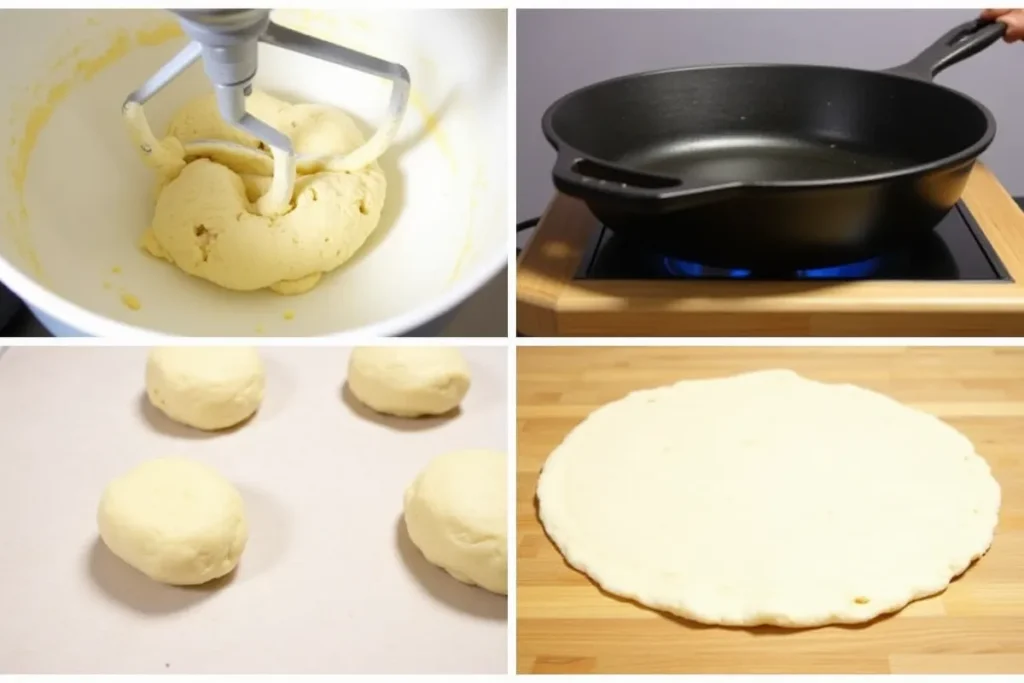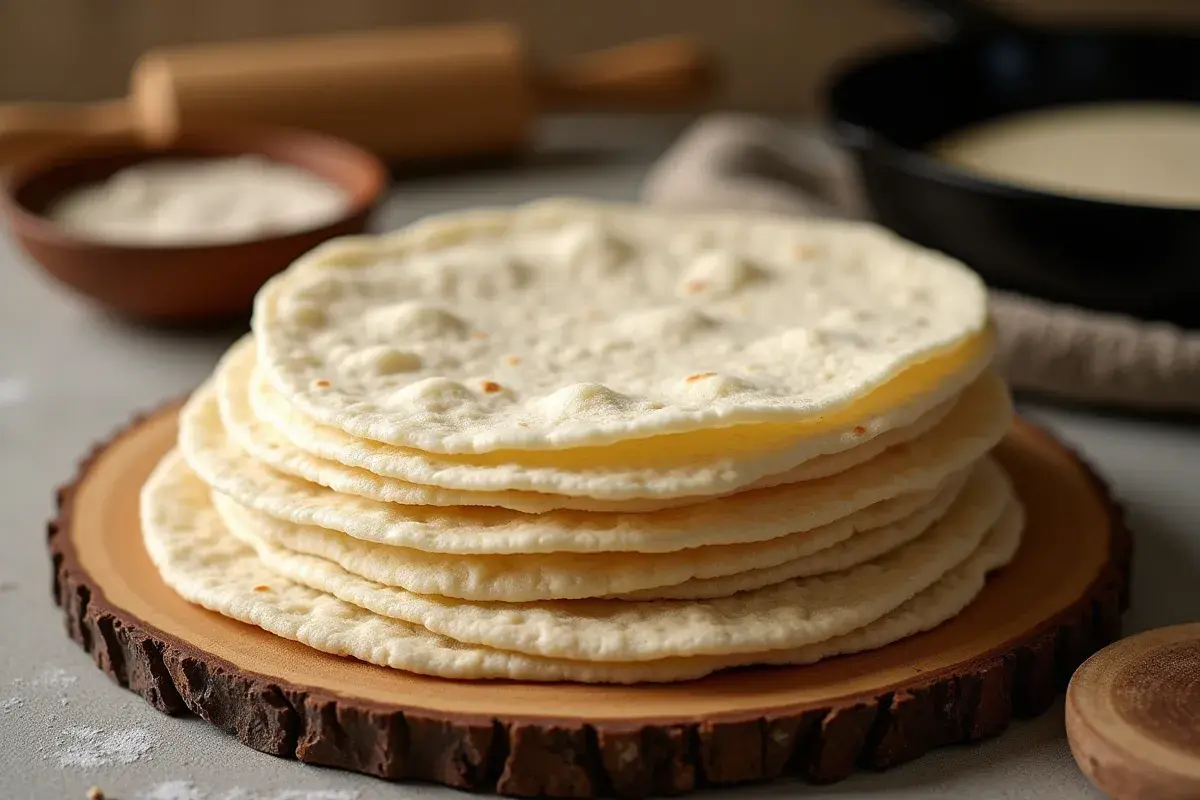Sourdough tortillas have captured the culinary world’s attention for good reason. They combine the tangy complexity of a fermented dough with the comforting warmth of classic tortillas. Whether you’re a sourdough enthusiast or just curious about new ways to enjoy tortillas, this comprehensive guide will walk you through everything from the rich history of sourdough to simple tips for crafting your very own sourdough tortillas at home.
In this article, you’ll discover best practices for fermentation, kneading, and cooking. You’ll also learn how these tortillas can elevate your meals in unique ways. Moreover, you’ll see how to handle sourdough discard, create easy routines, and add extra flavor to your table. Sourdough tortillas offer you the chance to enjoy a timeless favorite in a new, nutritious, and incredibly satisfying form.
A Brief History of Tortillas and Sourdough
Tortillas are deeply rooted in Mesoamerican cuisine. They predate the Spanish arrival in the Americas, making them one of the oldest staple foods in the region. Traditionally, tortillas were made using ground maize or corn flour (masa). Over time, wheat flour tortillas emerged, particularly in Northern Mexico and the southwestern parts of the United States.
Meanwhile, sourdough has a similarly ancient heritage. People have been harnessing wild yeast and lactic acid bacteria for thousands of years. Sourdough bread and other naturally leavened staples trace back to the dawn of agriculture. With both tortillas and sourdough boasting a long cultural lineage, sourdough tortillas represent a fusion of two time-honored practices.
Key Points to Remember:
- Corn tortillas date back to pre-Columbian times.
- Wheat tortillas gained popularity in the colonial era.
- Sourdough is one of the oldest forms of bread fermentation.
- Sourdough tortillas combine both worlds: the simple flatbread style of tortillas and the tang of naturally fermented dough.
Why Sourdough Tortillas?
Many people wonder what makes sourdough tortillas so appealing. The short answer is flavor and nutrition. Sourdough fermentation breaks down gluten and phytic acid, making these tortillas easier to digest than their non-fermented counterparts. Moreover, the tangy flavor profile achieved through natural fermentation creates a tortilla that tastes richer and more complex.
Nutritional Advantages
- Improved Digestibility: Fermentation partially breaks down proteins, potentially reducing bloating for some individuals.
- Better Mineral Absorption: Sourdough fermentation lowers phytic acid, which can allow your body to absorb more minerals, such as iron and zinc.
- Lower Glycemic Index: Because of the fermentation process, sourdough tortillas may cause a slower rise in blood sugar levels, providing a steadier source of energy.
Flavor Benefits
- Complex Tang: The lactic acid bacteria add a signature sour flavor, making these tortillas taste exceptional on their own.
- Enhanced Texture: The fermentation process can yield a softer, more pliable tortilla, perfect for wrapping or folding.
- Versatile Base: They work well with a variety of fillings, from grilled vegetables to savory meats.
However, it’s important to note that flavor results can vary based on your specific sourdough starter and fermentation conditions. Therefore, keeping track of your process helps in refining the taste.
Understanding the Science of Fermentation
To master sourdough tortillas, grasping the basics of fermentation is key. Natural starters rely on wild yeasts and bacteria to transform simple flour and water into a living culture. When you mix this culture into tortilla dough, these microorganisms break down complex carbohydrates into simpler components.
The Role of Wild Yeasts and Bacteria
- Wild Yeasts: These invisible fungi feed on sugars in flour, producing carbon dioxide. This gas leavens the dough.
- Lactic Acid Bacteria: They metabolize sugars to produce lactic acid, which contributes the sour note.
Together, these microorganisms result in dough that tastes tangy, has a soft texture, and offers potential digestive benefits. For example, a longer, cooler fermentation usually yields a more pronounced sour flavor.
Essential Equipment and Ingredients
While sourdough tortillas can be made with basic kitchen utensils, having the right tools streamlines the process. Below is a list of essential items to consider:
- Mixing Bowls: Opt for glass or stainless steel to avoid contamination.
- Measuring Cups and Spoons: Consistency in ingredient measurements leads to predictable results.
- Kitchen Scale: Measuring flour and starter by weight improves accuracy.
- Rolling Pin or Tortilla Press: Achieve a thin, uniform tortilla shape.
- Cast Iron Skillet or Comal: Distributes heat evenly and retains warmth for cooking.
- Bench Scraper: Helpful for handling sticky dough.
Key Ingredients
- All-Purpose Flour or Whole Wheat Flour: Use high-quality flour for best results.
- Sourdough Starter: This is the heart of your tortillas, providing both leavening and tang.
- Water: Adjust hydration carefully to achieve the desired dough consistency.
- Salt: Enhances flavor and helps regulate yeast activity.
- Oil or Butter (Optional): Adding fat can yield a softer tortilla.
Therefore, gather these items and ingredients beforehand for a smoother cooking experience.
Preparing Your Sourdough Starter
Your sourdough starter should be lively and active before it’s added to the tortilla dough. Typically, you’ll feed your starter several hours prior to using it. For example, if you feed it in the morning, you may be ready to make dough by the afternoon.
- Discard and Feed: Remove a portion of the starter (often called sourdough discard) and replenish with fresh flour and water.
- Wait for Activity: Observe bubbles, volume increase, and a mild sour aroma.
- Test the Float: If you drop a small spoonful of starter in water, it should float when it’s ready for use.
However, if your starter isn’t floating, it may still work. A float test isn’t foolproof. Trust the visual cues of bubbles and a sour smell. That said, a less active starter could prolong fermentation time.

Step-by-Step Guide to Making Sourdough Tortillas
Below is a concise yet detailed method. Sourdough tortillas require patience, but the reward is a delicious, nutrient-packed flatbread with a unique twist. Let’s dive in.
1. Mix the Dough
- Ingredients
- 2 ½ cups of flour (all-purpose or whole wheat)
- ½ cup active sourdough starter
- ¾ cup lukewarm water
- 1 teaspoon salt
- 2 tablespoons oil (optional)
- In a bowl, whisk flour and salt together.
- Create a well in the center, then add sourdough starter and water.
- Combine ingredients to form a shaggy dough. If it’s too dry, sprinkle more water; if too wet, add a bit of flour.
- Knead the dough for 5–7 minutes or until smooth.
2. Rest and Ferment
Cover the bowl with plastic wrap or a damp towel. Let it rest for 2–4 hours at room temperature. The dough will become more elastic and may puff slightly. Therefore, place it in the refrigerator if you need a slower, overnight fermentation.
3. Divide and Pre-Shape
Divide the dough into 8–12 equal pieces, depending on your preferred tortilla size. Roll each piece into a ball. Let them rest for 10–15 minutes to relax the gluten, ensuring easier rolling or pressing.
4. Roll or Press the Tortillas
Flatten each dough ball with a rolling pin or tortilla press. Aim for an even thickness, around 1–2 millimeters. For example, if you prefer thick tortillas, you can opt for 2–3 millimeters.
5. Cook on a Skillet
- Preheat a cast iron skillet or comal over medium-high heat.
- Place one flattened dough disc on the skillet.
- Cook for about 30 seconds or until small bubbles appear. Flip and cook for another 20–30 seconds.
- Adjust heat to prevent burning but maintain enough heat to cook the tortillas quickly.
6. Keep Them Warm
Stack the cooked tortillas and cover them with a clean cloth. This keeps them soft and prevents drying out as you finish cooking the rest.
Techniques for Perfectly Thin Tortillas
Crafting sourdough tortillas that are both sturdy and delightfully thin can be challenging. However, these tips will help you master the texture:
- Resting the Dough: Allowing the dough to rest after kneading relaxes the gluten. This makes rolling easier and prevents shrinkage.
- Light Dusting of Flour: Use minimal flour when rolling, to avoid toughening the dough surface.
- Steady Pressure: Roll from the center outward. Apply firm but even pressure.
- Hot Cooking Surface: A well-heated skillet quickly sets the structure, reducing the chance of overly thick tortillas.
Therefore, pay attention to these steps for a successful tortilla-making session. If your tortillas puff dramatically, that’s a good sign of adequate heat and fermentation.

Flavor Variations and Add-Ins
One of the best parts about sourdough tortillas is their adaptability. You can infuse your dough with various herbs, spices, or other ingredients. These additions bring diverse flavors and even extra nutrients.
Popular Add-Ins
- Fresh Herbs: Minced cilantro, chives, or basil.
- Spices: Paprika, cumin, or chili powder.
- Cheese: A small amount of shredded cheddar or mozzarella.
- Whole Grains: Replace a portion of the flour with whole wheat or spelt for added fiber.
Sweet Variations
- Cinnamon and Sugar: Lightly dust the rolled-out dough with a cinnamon-sugar mix.
- Honey: Drizzle honey over the warm tortilla for a sweet treat.
For example, you could pair cinnamon-sugar sourdough tortillas with fresh fruit for a quick dessert. Additionally, sprinkling seeds like flax or chia can boost the nutritional profile.
Serving Suggestions and Pairings
Sourdough tortillas elevate almost any dish. Their tangy flair pairs well with both savory and sweet flavors. However, choosing the right filling or side dish can make them truly memorable.
Breakfast Ideas
- Breakfast Burritos: Stuff tortillas with scrambled eggs, cheese, and sautéed vegetables.
- Sweet Crepe-Style Wrap: Spread nut butter or jam for a quick morning snack.
Lunch or Dinner Wraps
- Chicken Fajitas: Add grilled chicken, onions, peppers, and fresh salsa.
- Veggie Wrap: Fill with roasted veggies, hummus, and crunchy lettuce.
- Taco-Style Filling: Use ground beef or tempeh spiced with chili and cumin.
Snacks and Sides
- Tortilla Chips: Cut sourdough tortillas into triangles, brush with oil, and bake.
- Quesadillas: Layer cheese, leftover chicken, or beans between two tortillas.
For example, if you want a light meal, top a grilled tortilla with fresh salad ingredients for an open-faced sandwich. Conversely, go for a hearty burrito for a filling dinner option.
Storing and Reheating Sourdough Tortillas
Proper storage preserves the taste and texture of your sourdough tortillas for several days. Therefore, follow these guidelines to enjoy their freshness over multiple meals.
- Room Temperature: Store tortillas in a sealed plastic bag or airtight container for up to 2 days.
- Refrigeration: Extend their shelf life to about a week by placing them in a sealed bag in the refrigerator.
- Freezing: Layer tortillas with parchment paper to prevent sticking, then seal in a freezer-safe bag. They’ll keep for up to 3 months.
Reheating Tips
- Skillet Reheat: Warm each tortilla on a hot skillet for 10–15 seconds per side.
- Microwave: Stack tortillas with a damp paper towel on top and heat in 10-second intervals.
- Oven: Wrap in aluminum foil and warm at 300°F (150°C) for about 10 minutes.
However, avoid overheating, as tortillas can become dry or brittle. If you notice dryness, a quick spritz of water before reheating can help restore moisture.
Common Mistakes to Avoid
Making sourdough tortillas might be straightforward, but certain pitfalls can cause frustration. Here are common mistakes and ways to avoid them:
- Using an Inactive Starter: Ensure your starter has been recently fed and shows signs of bubbling.
- Over-Kneading or Under-Kneading: Knead just enough to achieve a smooth dough. Overworking can make tortillas tough.
- Skipping the Rest Period: Dough needs time to relax. Otherwise, it may shrink and resist rolling.
- Cooking at the Wrong Temperature: Too high and they burn; too low and they dry out. Aim for a moderate-medium heat.
- Poor Storage: Failing to seal them properly leads to rapid staleness.
Therefore, remain mindful of these details. Soon, you’ll be producing consistently delicious tortillas every time.
Frequently Asked Questions (FAQ)
How to Make Sourdough Tortillas?
To make sourdough tortillas, mix flour, salt, and an active sourdough starter with lukewarm water. Knead into a soft dough. Allow it to ferment for a few hours. Divide into small balls, roll them thin, and cook on a hot skillet for 30–60 seconds per side.
Can You Make Sourdough Tortillas?
Absolutely. If you have a thriving sourdough starter, you can create delightful tortillas at home. The fermentation imparts a subtle tang while maintaining a soft texture.
How to Make Sourdough Discard Tortillas?
Sourdough discard tortillas follow a similar process. Use the portion of your starter you typically throw away. Just note that discard may be less active, so adjust rest or fermentation times as needed. The flavor remains tangy and delicious.
How to Make Tortillas from Sourdough Discard?
To prepare tortillas from discard, combine the discard with flour, salt, and water (plus optional fat). Knead briefly, let the dough rest, and then shape. Cook in a hot skillet until lightly browned on both sides.
Conclusion: Embrace the Tangy Twist
Sourdough tortillas combine heritage, science, and flavor in one simple package. By harnessing the natural power of wild yeast, you elevate ordinary tortillas into a mouthwatering culinary experience. Whether you enjoy them plain or dressed up with your favorite fillings, these tortillas offer a uniquely tangy, nutrient-dense alternative.
Furthermore, they open up a world of creativity. You can experiment with herbs, sweet toppings, or even leftover sourdough discard. Therefore, don’t hesitate to try new techniques and flavor combinations. After a few practice rounds, you’ll be amazed by how simple and rewarding making sourdough tortillas can be.
Happy fermenting and cooking!

